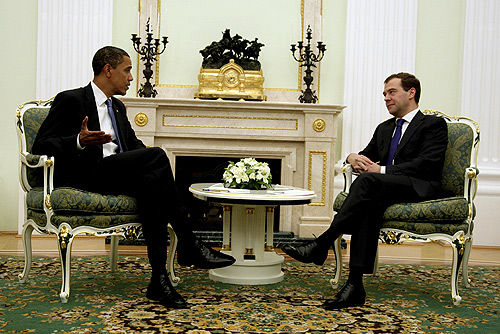
The U.S. and Russia are close to an agreement that will make major cuts in their nuclear stockpiles, President Obama said last week. It is seen as a step in the direction of complete nuclear disarmament, a goal Obama has strongly advocated.
Obama made the announcement Dec. 16 after meeting with Russian President Dmitry Medvedev in Copenhagen during the United Nations climate conference. The two leaders both said they expected to reach an agreement soon. Talks are expected to continue in January.
The new pact would take the place of the original Strategic Arms Reduction Treaty, START, which was signed in 1991 and expired Dec. 5. That treaty, by the time it was fully implemented in 2001, resulted in the removal of about 80 percent of all strategic nuclear weapons then in existence.
The new treaty, known as New START, is expected to reduce deployed long-range nuclear warheads from 2,200 to between 1,500 and 1,675 for each country. It is also expected to slash the number of aircraft, submarines and intercontinental ballistic missiles that can carry such long-range nuclear warheads or bombs, from 1,600 to about 700 or 800.
This is seen as a significant step toward eliminating the two countries’ roughly 20,000 nuclear bombs and warheads. The Obama administration says it wants New START to lead to talks on further reducing nuclear weapons.
The election of Obama “has provided an opportunity for unprecedented progress on nuclear weapons,” John Isaacs, head of the Council for a Livable World, said in a speech to the Carnegie Council for Ethics in International Affairs earlier this month. In addition to Obama’s personal commitment to the goal of a nuclear-weapons-free world, said Isaacs, the president “has also surrounded himself at the highest levels with experts on nuclear non-proliferation and nuclear weapons policy.”
But ratification of the new treaty can expect to face stiff opposition from Senate Republicans. They are already making a big fuss about verification. Ratification of a treaty requires a two-thirds vote – 67 votes in the 100-member Senate.
A new START agreement will give momentum to an international conference in May that will review the 1968 Nuclear Non-Proliferation Treaty and consider ways to strengthen it. Under the Non-Proliferation Treaty, 189 countries have agreed not to develop nuclear weapons in exchange for gradual disarmament by the nine countries that have nuclear weapons.
The U.S. and Russia possess more than 90 percent of the world’s existing nuclear weapons. But proliferation poses a serious threat, experts say. There is enough nuclear material across the globe to enable the creation of hundreds of thousands of additional nuclear weapons, Isaacs warned. That presents “the risk of catastrophic accidents, errors or unauthorized use,” he said.
A new arms reduction agreement with Russia will also give impetus to Obama’s vow to press for Senate ratification of the Comprehensive Nuclear Test Ban Treaty, possibly in the next several months. Adopted by the United Nations General Assembly in 1996, the treaty was defeated by the Republican-controlled Senate in 1999.
It bans all nuclear explosions, whether on the earth’s surface, underground, in the atmosphere or underwater. That would make it difficult for countries to develop new or more advanced nuclear weapons.
To date, 182 countries have signed the treaty and 150 have ratified it. Nine major countries that must ratify the treaty, according to its provisions, have not done so: the U.S., China, Pakistan, India, North Korea, Israel, Egypt, Indonesia and Iran. If the U.S. ratifies it, it is expected that others will follow suit.
Republican warhawks will likely fight this ratification as well. Winning Senate approval of the test ban treaty “will take skillful work by the Obama administration,” Isaacs said.
Photo: www.kremlin.ru. Creative Commons Attribution 3.0 Unported










